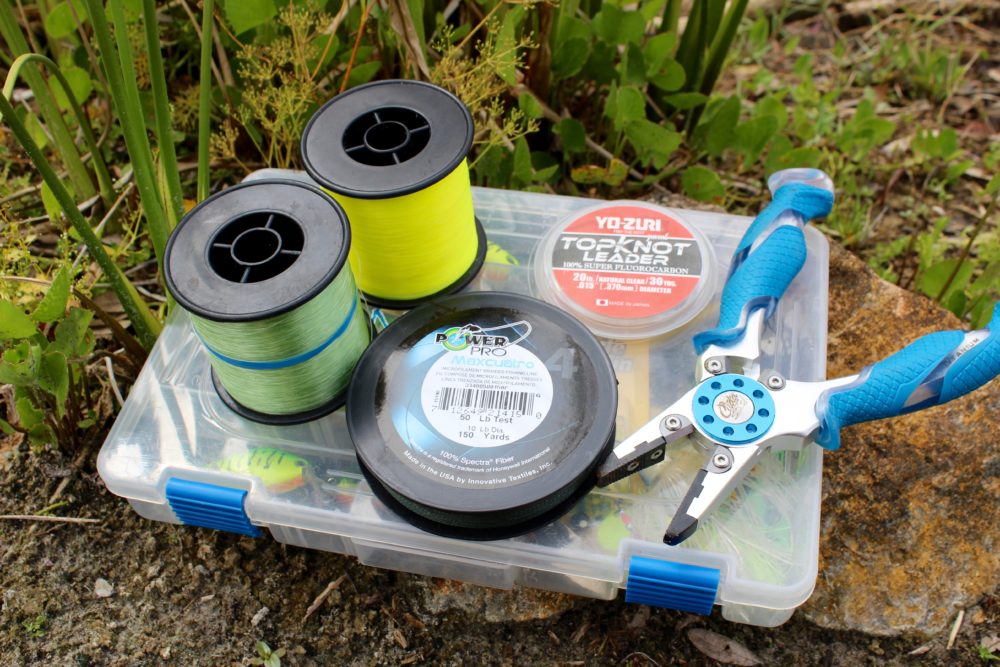Fishing resources and tips for the empowered female angler.
Which Type Of Fishing Line Should You Use?
February 5, 2015

Wondering what type of fishing line is best to use in which situations? Well, that depends on the type of fishing you plan to do and where you plan to do it. Since there are just three types of commonly used line, it won’t take you long to figure out when to use which type. Learn more about the advantages and disadvantages of using braid, monofilament, and fluorocarbon.
Braided Fishing Line
Braided line is made by fusing multiple strands of fibers together. Braided line is stronger per diameter than monofilament. In fact, you can often get up to about 60 pounds breaking strength in braided line that has the same diameter as 30-pound test monofilament. This extra strength means that braid is a good choice when you are fishing in areas of heavy vegetation or cover. Another benefit of braid is that it has little to no stretch, so it makes it easier to get a firm hookset. Braided line also tends to last longer than monofilament because it doesn’t break down as quickly after exposure to sun and saltwater.
Which situations may not be ideal for braid? Braid isn’t the best choice in clear water conditions when fish may be line shy, if you are fishing in an area with abrasive structure, or if you are prone to tangles. Braided line can take considerably longer to untangle than monofilament or fluorocarbon and requires sharper line cutters for clean cuts.
Braided Fishing Line Tips
- When using braid in windy conditions or when distance casting for long periods of time, keep the line tight to your reel spool. Otherwise, the slack can cause wind knots.
- If you want to cast lures or plugs, use braid because it will give you more sensitivity when working lures.
- When fighting a fish, use the flexibility of your rod so that you are less likely to pull the hook out of the fish’s mouth. Remember, braid doesn’t stretch like monofilament.
Monofilament Fishing Line
If you fished with a Snoopy pole when you were a kid, it was rigged with monofilament line. This is one of the most popular types of fishing line because it’s inexpensive, more resistant to abrasions, and has low visibility in clear water conditions. Monofilament also has natural stretch, which can be beneficial when it comes to keeping your fish hooked if it takes a long, hard run. The downside of monofilament is that it has greater diameter than braid. This means that you don’t get as much line capacity as you would if you were using braid.
Monofilament Fishing Line Tips
- When purchasing monofilament line, an important tip is to buy line with the lowest diameter-to-pound test ratio for best performance.
- Since monofilament breaks down when exposed to direct sunlight, it should be changed often. When in doubt, change it out.
Fluorocarbon Fishing Line
The major advantage of fluorocarbon line over monofilament or braid is minimal visibility. Fluorocarbon has very low light refraction, making it practically invisible underwater. This particular type of fishing line is stiffer than monofilament, and more abrasion resistant, so it is most often used for tying leaders to fishing lines.
Fluorocarbon Fishing Line Tips
- Fluorocarbon should be changed often since it also breaks down in sunlight, causing it to lose strength and invisibility.
- When fishing in clear water conditions, fluorocarbon is the best type of line to use as leader or main line for finicky fish that would otherwise be wary of monofilament or braid.
Remember that selecting the right line can mean the difference between landing or losing a trophy! Have more questions about the different types of fishing line and when to use which kind? Comment on this post or head over to the Shefishes2.com Facebook Page and ask away.